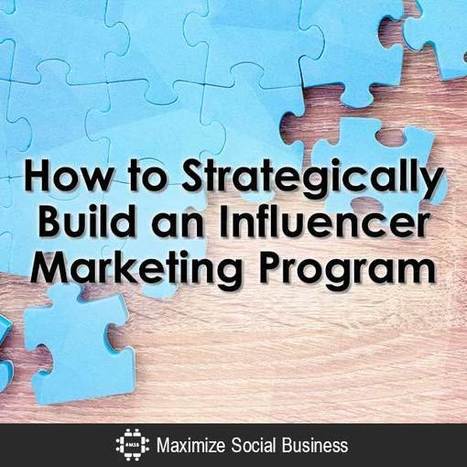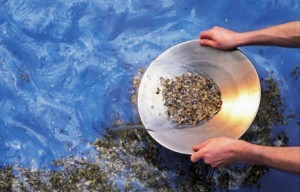 Your new post is loading...
 Your new post is loading...
For supporters of Britain staying in the EU, a simple question remains this morning: How did we fail to persuade voters of our position? Steve Martin, director at Influence at Work in London and best-selling author of several books on persuasion, spoke with HBR about the ways in which the Remain advocates’ message failed to get through, or even backfired. Martin was joined by Joseph Marks, a behavioral scientist on his team.
HBR: From a persuasion science point of view, how do you explain the vote for Britain’s exit from the EU?
Steve Martin: There seems to have been a focusing effect. The Leave side made sure that immigration became a focus. Not only a focus but the focus. And once that’s a focus it’s hard to get other messages through. What we see is all there is. Danny Kahneman said that clearly. We can only pay attention to a limited number of things and if we see that immigration story every day, that’s what affects us more than a rational argument that predicts what would happen if we left.
But they saw the economic arguments every day, too. Why couldn’t the Remain side focus the voters on that?
Joseph Marks: I think both campaigns were built around fear of loss. One was what we’re losing in terms of immigration coming in. And one was loss to the economy and your pocket. Normally that wins. That’s number one. But right now, you can see that immigration issue as happening now, in the present, whilst the economy is doing well. In the optimism literature, we’ve seen that people are generally optimistic about their own futures when the economy is good, so that’s maybe how the economic argument lost to something that feels more pressing to people. So ironically the very people who helped get our economy on track created an environment that makes it harder to communicate their message of potential negative impacts of leaving the EU. The health of the economy created a good economic environment that had a disproportionate influence over decision making at that moment....
As our influencer marketing columnist Raymond Morin blogged sometimes ago, there are 3 main types of influencers: - celebrities - opinion leaders (traditional media, online media, social media) - ambassadors (satisfied customers, happy employees).
With the democratization of social media influence, there are simply more people that yield influence in social media. Perhaps this is one reason why Influencer Marketing continues to soar in 2015. It really shouldn’t come as a surprise, because numerous stats have already documented the power of online recommendations...
The tide of influence hunting on the web is rising beyond public relations and social media to digital marketing at large. In particular, there’s growing attention being directed towards influencers as gateways to new audiences.
Influence as the ability for a person to inspire action amongst a community is a very powerful thing and therefore, increasingly appreciated by digital marketing and PR pros alike. An influencer program that identifies, qualifies, engages and maintains relationships with industry influencers can serve as a formidable “force multiplier” for everything from content amplification to product feedback to content co-creation. Beyond the “brandividual endorsement”, people with a strong center of influence can provide valuable context and credibility to a company seeking to connect with an audience of buyers. But in an age of information overload and the ability for anyone, anywhere to publish, finding those influential connections in your industry can prove to be a challenge.
Here are 9 of many tools that can be used for the initial task of finding influencers aligned with specific areas of subject matter expertise. Several go beyond discovery and also support filtering, managing, engaging, monitoring and reporting....
Millions of updates are shared on social media every day and years worth of content is spread along with it. When we log in to Twitter we are greeted with “What’s happening?” On Facebook it’s with “What’s going on?” Social media demands content from us and is driven by user-generated content, but it adds a lot of noise across the social media channels we are using and on the social web. Some organisations sport hundreds of followers and unique visitors to their blog every month while others have thousands of followers and generate so much more unique traffic. Which one has more influence? Of course you will think that the organization with a larger audience has more influence, and in some cases, you might be correct. But, digital influence goes so much further than the number of people following you or the traffic you are generating to your blog....
Campaigns are gearing up to shape social media reactions in real time. When President Obama and Mitt Romney take the stage for their first debate in Denver tomorrow night, a far more extensive shadow debate will unfold across social media. Campaigns and supporters will aim to seize the online "conversation" in a vast game of spin unfolding well beyond the telecast and media coverage. As a sign of just how pervasive and crucial social media has become, in some states elected officials are only one degree of "friend" separation from nearly every Facebook account holder in that state, says JD Schlough, a Democratic political strategist. And by one analyst firm's count, Twitter has 140 million U.S. users, more than 30 million of whom joined in 2012 alone. "All social media is a conversation, but the amount of people having that conversation in 2012 is a lot greater than it was in 2008. That conversation is going to happen whether the campaign influences it or not—so they better get their message out there and hold the other side accountable for mistakes," Schlough says.... Overall the goal is not just to more broadly deliver a message, but to ensure that it is delivered from trusted friends—the holy grail of marketing. After all, you are more likely to see a movie when a friend recommends it, rather than if you've seen an advertisement. That's why campaigns want to use all means possible to prime social media to distribute talking points in real-time. "If we know that people believe stuff they hear from friends more than politicians, and one of them does something stupid, or smart—or if there is a contrast on an issue—it amplifies the impact of the debate to hear and to react and add your own spin," Schlough says. "Much like the convention, they will seek to use the social media to capitalize on the good moments and fact-check the hits the other side is throwing."... [Here's a great analysis of the impact of social media post-debate ~ Jeff]
A couple weeks ago, I'm sure you noticed Cision published a list of the top 50 PR and marketing blogs. These kinds of lists are a dime a dozen–I should know, I create a bunch of them. But, this one had a bit of process behind it as Cision used its proprietary Cision Influence Ratings to create the list. I would imagine that tool takes some kind of algorithm of unique visitors, comments and social scoring into consideration before giving a blog one of the “scores” we see in the list (note: I have never used the Cision tool).
But, what I didn’t see the last couple weeks was a lot of discussion about this list. If this list had come from an independent blogger (like me, for example), I probably wouldn’t bat an eye. When it comes from an organization like Cision, I take a closer look.
So, I took a closer look. Here’s what I found in terms of facts....
[An interesting look at influencers by Arik Hanson - JD]
Influencer targeting is one of the cornerstones of the agile engagement framework. To learn more about how to make agile engagement work for your organization, download our free white paper, The Dawn of Agile Engagement.... [This terrific infographic speaks for itself - JD]
|
This week I moderated another Social Media Today webinar as part of their Best Thinker webinar series, this time on the topic of The ROI of Influencer Marketing. This webinar featured Eric T. Tung (@EricTTung) Brand Ambassador for companies like Ford, Microsoft, Verizon and MasterCard, Kathleen Hessert (@KathleenHessert) CEO of Sports Media Challenge and Eric Berkowitz (@tracx) SVP of Global Services at Tracx. This webinar was sponsored by Tracx. We discussed ideas and tips from finding influencers for your brand to calculating ROI on your program.
Here are three key takeaways from the webinar:
- Not all influencers are created equal – Brands should look beyond social metrics into psychographics and contextual intelligence to determine the ideal candidates
- Bigger doesn’t mean better – A large following or readership does not inherently make a person influential
- The ROI of Influence – True influence drives action, not just awareness...
When it comes to winning the hearts (and dollars) of potential consumers, a positive consumer review can go a long way. A new report shows that more than two-thirds of US Internet users trust businesses more because of positive consumer reviews.
The high levels of trust represent a significant shift. Five years ago, 45 percent of consumers said they didn’t pay attention to online reviews at all or didn’t let them influence them,eMarketer reports. But in 2015—in part because of increased mobile use—reviews are a big part of users’ online shopping experience. Thirty-eight percent of Internet users read reviews on mobile via a browser, and 24 percent on mobile apps....
I’m often asked by companies who have hired us for Social media consulting “should we use something like Kred or Klout in our hiring process?” This question makes me cringe and my answer is always: absolutely not. But, and yes, there’s a but, you can use them to gain some insight as to what someone is about. It has always amazed me how quickly social media managers, HR managers and even CTO’s jump to adopt new measurement tools, analytics and data, just because someone comes out with it. A brief look at a couple of the most well-known social media influence measurement tools and my opinion....
...I agree that content curation is often misunderstood and, therefore, misused as a shortcut to thought leadership. And I have no quarrel with the point that you need to create your own content that articulates your vision in order to establish thought leadership.
However, I would say it differently.
Thought leadership is about demonstrating clarity of vision and in order to establish it you need to create content that expresses that vision. But you also need to show that you can recognize that vision in others. To my mind, thought leaders both articulate their own vision and identify it and tease it out of other people’s work. It’s not an either/or proposition....
Right answers to wrong questions virtually guarantee failure. Innovators betting on "out of the box" thinking or "faster, better, cheaper" innovation paradigms for success all too frequently find themselves — and their customers — disappointed. Hey folks -- this is a pivotal article about biz storytelling. Why?? Because it addresses the most neglected aspect of effective business storytelling -- the story about the future that you and your customers/clients are creating together. What I love about this article is its twist -- the level of biz storytelling these days is mostly focused on how to authentically share stories about your products/services, people, or founding to capture the hearts and minds of propsects and build loyal customers. That is OK as far as it goes. But there could be more. Way more. Instead of asking, "What do our customers want [and how do I share a story about that]?" how about asking, "What do our customers want to become [and what is the story I can share about that]?" What a fundamentally different -- and better -- question! Org story advice for crafting 'Future Stories' is typically "Write a newspaper article about your company 5 years from now & the awards you are receivng" or some such version of that. Not bad. But there could be more -- way more. When we start asking ourselves the questions posed in this article, whole new worlds start opening up. 'Future stories' are really about the future we are creating together with our customers/clients -- it is the call to be part of something bigger than ourselves. Go read this article -- quickly! You will be glad you did because it will get you to fundamentally shift how you think about and share about your business, and the stories you tell about it. And if you need a really great example of a company doing this, then check out this latest Nike video. http://www.cbssports.com/olympics/blog/eye-on-olympics/19654085/video-nikes-new-olympics-ad-greatness-is-for-all-of-us ; And if you want to review a written form of this, then check out my Manifesto on my website. The Manifesto is still a work in progress, but you will get the idea. http://www.juststoryit.com/FutureStory ; Enjoy this short article -- its insights, questions, and a different kind of conversation we can have about business storytelling. This review was written by Karen Dietz for her curated content on business storytelling at www.scoop.it/t/just-story-it ;
Most of us are in love with the idea of influence. Some time back, Malcolm Gladwell came up with an easy to understand model of influence. It seemed to resonate with many of us who are deeply immersed in the web and have seen, first hand, the apparent randomness of online sentiment and human digital behaviour. His book, The Tipping Point took its lead from Stanley Milgram’s principle that we are all only separated by six degrees – suggesting that within a network, the “hub” or “connector” plays a vital role in the transmission of information across that network. I have always viewed this theory with scepticism – preferring the strength of weak ties model popularised by Duncan Watts. It’s a shame in a way, as the Gladwell model – the Tipping Point – is easily articulated and understood, while Watts’ approach is more complicated, random and difficult to apply in the real world. Yet, even a casual glance at the social media landscape will show you just how difficult it can be to boil “influence” down to a single factor or variable. Klout has tried it as have PeerIndex and Kred – and there are dozens more on the horizon offering different versions, metrics and tools that attempt to measure the chaos of our behaviours and patterns of indifference. Ultimately, when it comes to influence, I keep returning to one important point –> it’s not about influence, it’s about trust. And until we, as business leaders, as marketers and as publishers of information and content, understand this, we will continue to dance around the real issue....
Online influencer outreach is a big part of the social media playbook, but we confuse audience and influence, and overlook advocacy. Here's how to reconfigure. Trying to convince online influencers to tweet, blog, instagram, or pin nice things about your company is the post-modern version of celebrity endorsement, but with less impact.
Public relations firms and/or in-house communication apparatchiks take the same concepts and mechanics of celebrity endorsement and bring them online, using Klout scores in lieu of celebrity Q scores, and blogger ID software like Group High in place of Hollywood agents. The idea is that once drafted into the cause and compensated in some way, online influencers will spread the word in social media to their acolytes, increasing sales for the brand. But these programs often prove ineffective at driving behavior beyond social chatter. There are two reasons for this.... [Jay Baer offers great insight into REAL online influence - JD]
|




 Your new post is loading...
Your new post is loading...






















Valuable lessons from Brexit for marketers and politicians alike.